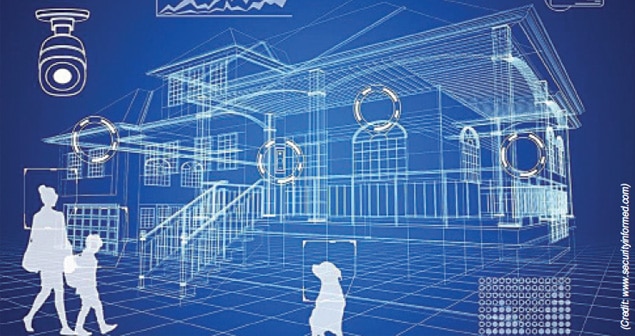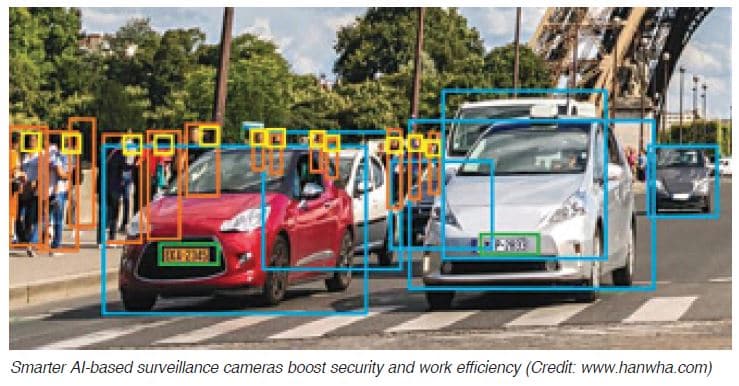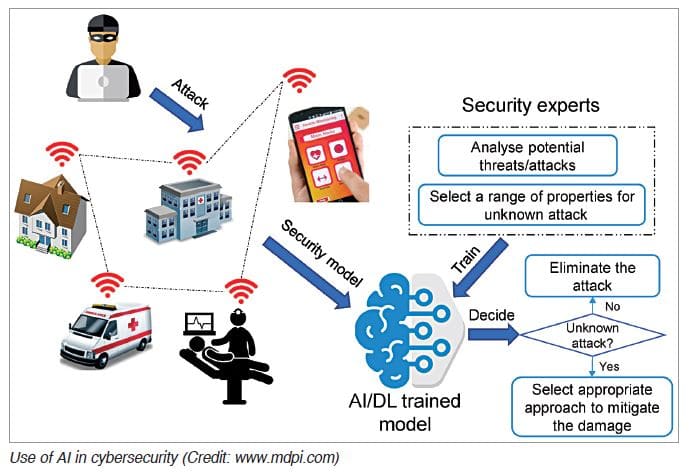- Contact Us
- +91-98111-55335
- [email protected]

You Can Travel In Drones And Eat Them Too
May 23, 2020
“India’s Tech Ecosystem Encompassing IoT Deployment Is At Curious Crossroads”
May 23, 2020Artificial Intelligence For Upgraded Surveillance And Better Security

Artificial Intelligence has been playing a key role in surveillance and achieving better security by preventing dangerous situations. AI cameras make real-time monitoring and intelligent analysis of the footage possible that can prevent occurring of events such as theft
Artificial intelligence (AI) has brought about startling developments in numerous sectors including manufacturing, automotive, healthcare, entertainment, finance, among others, while still being in its nascent stage.
Of all the applications, the use of AI along with deep learning and machine learning in surveillance is growing by leaps and bounds due to its profound impact in achieving security by preventing dangerous situations. According to a recent report by ResearchAndMarkets.com, the global video surveillance market size is expected to grow at a CAGR of 10.4 per cent from 45.5 billion dollars in 2020 to 74.6 billion dollars by 2025.

AI taking over passive surveillance solutions
While the installation of CCTV cameras to stream live videos on screens has been done on a massive scale globally, be it in retail stores, hospitals, offices, among others, they are usually passive and only paid attention to after an incident of breach has taken place or there is information about a potential threat. Also, interpretation can be a daunting task as the massive data obtained cannot be utilised to full extent in conventional systems. AI cameras are more intrusive and make real-time monitoring and intelligent analysis of the footage possible that can prevent occurring of such events.
Mostly, low-resolution cameras are utilised for recording, resulting in poor quality images. AI can be used for sharpening unclear images to draw meaningful insights. No matter, the resolution, facial, object, and event recognition become much easier. Recognition can even be done from someone’s physical characteristics like height, posture, and build as well as activity patterns.
This is also beneficial since human operators tend to miss out on crucial details, which can have serious consequences, due to reasons such as mental and physical fatigue from continuous monitoring. AI ensures that there are no errors and attention span issues. When remote monitoring in places like factories is required, ideal conditions and performance parameters can be programmed into the AI system and it can alert operators, save costs, and prevent machine failures.
Behind the functioning of AI
Machine-based learning algorithms are used to monitor and analyse the images, videos, and data recorded from surveillance solutions. The most common type of AI is rule-based wherein the programmers feed the system with pre-designed rules that must be true in an ideal situation. But slowly the use of behavioural analytics that does not need pre-defined rules is growing. The self-learning system works by auto-detecting and classifying data related to the target environment.
Automated platforms allow smooth collection and storage of information coming in from multiple sources. AI platform Ella by IC Realtime, for instance, makes the data instantly searchable. Users can even narrow down their results by filters like time range and location as well as give their feedback by rating their relevance.
When it comes to surveillance, AI can utilise machine-based vision and be trained to observe every detail in the livestream, or record and notify the operator in case of even the slightest deviation from activity (incidents, behaviour, or actions) that is usual in the ideal scenario that it has been fed, ensuring proactive real-time security. Data fed into the algorithms can include geographic location, biometric data, social media feeds, history of arrest, among others. Deep learning has heavily engineered neural networks that can detect objects in real-time. Popular methods include faster Region-CNN (RCNN), You Only Look Once (YOLO), and the Single Shot Detector (SSD) networks. The choice of algorithm depends on parameters like speed, accuracy, size, and so on.
For training the surveillance system, training the model is done after data preparation. For the last step—inference, if the processing is done on the edge, onboard GPUs need to be used, or models with lower accuracy need to be used since microcontrollers are not as powerful as GPUs.
Facial recognition uses both video footage and still images for not only a person’s identification via database matching but for even more in-depth purposes like expression analysis through crowd scanning and analysis of other similar trends. Evolv Technology, for example, offers a security system that consists of a screening machine and facial recognition application. The screening device detects metallic and non-metallic explosives and other dangerous weapons, while the facial recognition algorithms match the faces on the cameras with the watchlist in the database.
Where can it be used?
When it comes to national security, AI-enabled solutions can detect unattended objects like bags in airports and other places like metros and railway stations, easing the work for security personnel. Also, passengers can be verified through facial recognition along with biometric travel documents. If they do not get cleared, manual screening can be done to meet the requirements. This is even suitable for border control systems.
With mobile surveillance bots like micro drones, large areas of land can be covered. Startup Shield AI, for instance, offers Hivemind Nova drone and machine learning applications that the team says helps military or security personnel in surveillance of even GPS absent high threat environments.
Amongst the main aspect of smart cities is better security by predicting, preventing, addressing, and reducing crimes and other emerging threats to make them safe cities. Smart cities typically use an array of sensors, tracking devices, and surveillance technology to gather information in real-time from interconnected devices. The information relevant to city operations is then centrally processed and analysed. AI-based surveillance can monitor crowds in retail stores and identify those who have potential chances of engaging in activities like shoplifting.
As systems become smart and everything is connected, they also become vulnerable to cyber-attacks. Facial recognition technology has also been incorporated in many smartphones for protecting user data from outside attacks and hacks. AI and deep learning can detect such threats quickly and are being leveraged in most cybersecurity software and products in the market these days.
Impact of Covid-19 pandemic
Amidst the need for social distancing during Covid-19 lockdown across different countries, AI-based technological solutions that enable contactless functioning are at their peak. Startup Landing AI has created an AI-enabled social distancing detection tool that represents each individual in the video as a dot and turns bright red when the computed distance between two people is less than 1.8 metres (six feet).

In India, Vehant Technologies, a physical security and surveillance solutions manufacturer, recently launched Covid Analytics – an AI and computer vision-based intelligent image analytics solution. It detects violations through face mask detection, social distance detection, and vehicle movement detection through automatic number plate recognition (ANPR). It can be deployed both indoors and outdoors.
Enabling technologies
AI does not work in isolation to achieve its goal. Technologies like the Internet of Things (IoT) and cloud computing play a key role in the success of AI implementation in security systems. This is what makes devices like smart speakers, automotive built-in cameras and remote keyless entry locks behave as efficient tools for AI-powered surveillance. As an increasing number of devices get connected to each other in IoT systems, huge amounts of data need to be shared for processing. Giants like Microsoft, Alibaba, Amazon, IBM have cloud computing data centres, a more secure method of data storage and communication than traditional on-site infrastructure, for facilitating AI tasks. The data stored in cloud servers is usually accessible through the Internet. After connecting hardware to the cloud via 4G/5G networks, specialised software works to interpret this Big data collected from different locations and allows users to observe necessary measures to protect both people and assets.
Future scope
Although AI helps in spotting crimes and accidents easily, it also raises serious concerns about the future of privacy and risks to the current social structure. If companies and governments fail to take adequate steps to monitor and control the privacy violations in this field, it can have disastrous consequences. The opacity regarding the usage of data obtained in the process of surveillance varies in different nations.
Processing large amounts of information is necessary to obtain that one useful data, which implies heavy computing with multiple algorithms that require hundreds of servers. This wastage of resources leads to over-the-top expenditure on hardware. This limits its expansion in a country like India where hardware is usually imported from other countries. When quality is often lowered to maximise storage, deep learning algorithms need to be able to evaluate these low-quality images. Also, the Internet connection needs to be faster for limited latency in processing data.
In addition, it is not always accurate or even fair, as seen from the soaring use of deep-fake videos. Take face recognition systems, for example, when the weather is poor or the images are distorted, false positives are high. Other reasons for the high false-match rates are consistent biases related to minorities and genders in AI training datasets and prejudice due to predictive policing tools. Such inconsistency is highly risky when it comes to situations of national/international importance.
In spite of the challenges, the spread of AI is undoubtedly proliferating. Innovative solutions are coming up and everyone from widely recognised security vendors to startups are contributing to these surveillance and security operations. Huawei, IBM, NEC Corporation, Hikvision, Cisco, ZTE are among the prominent companies that cater to AI surveillance necessities of most countries. There is a crucial need to not just blindly leverage the benefits of AI in surveillance but to establish a balance between AI technology, government surveillance, and the privacy rights of citizens.
—Ayushee Sharma
